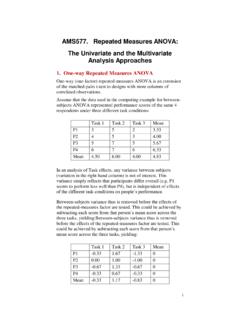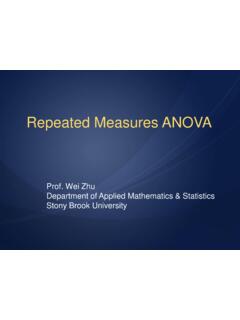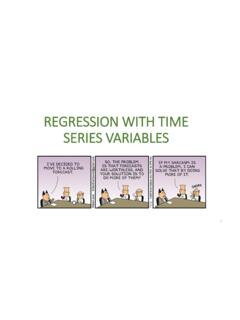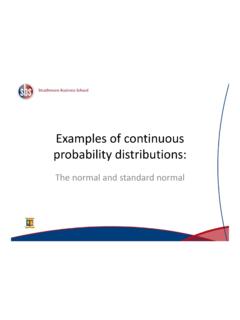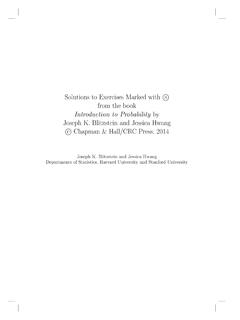Transcription of Chapter 3: The basic concepts of probability
1 Chapter 3: The basic concepts of probability Experiment: a measurement process that produces quantifiable results ( throwing two dice, dealing cards, at poker, measuring heights of people, recording proton-proton collisions) Outcome: a single result from a measurement ( the numbers shown on the two dice) Sample space: the set of all possible outcomes from an experiment ( the set of all possible five-card hands) The number of all possible outcomes may be (a) finite ( all possible outcomes from throwing a single die; all possible 5-card poker hands) (b) countably infinite ( number of proton-proton events to be made before a Higgs boson event is observed) or (c) constitute a continuum ( heights of people) In case (a), the sample space is said to be finite in cases (a) and (b), the sample space is said to be discrete in case (c), the sample space is said to be continuous In this Chapter we consider discrete, mainly finite, sample spaces An event is any subset of a sample set (including the empty set, and the whole set) Two events that have no outcome in common are called mutually exclusive events.
2 In discussing discrete sample spaces, it is useful to use Venn diagrams and basic set-theory. Therefore we will refer to the union (A U B), intersection, (A B) and complement ( ) of events A and B. We will also use set-theory relations such as A U B = A B (Such relations are often proved using Venn diagrams) This is also called De Morgan s law, another half of De Mogan s law is: = A dice has six sides, each side has a distinct number (1-6) dots Some terminology used in card game Flush: A flush is a hand of playing cards where all cards are of the same suit. Straight: Three of a kind: : outcome = 5-card poker hand sample space S: 2,598,960 possible 5-card hands (2,598,960 outcomes) A: at least 1 number repeats : no numbers repeat B: straights C: straight flushes D: a number repeats 2x E: a number repeats 3x D E: full house Event C (straight flush) has 40 outcomes The sample space is drawn as a Venn diagram An experiment might consist of dealing 10,000 5-card hands De Morgan s Law (1): = De Morgan s Law (2): = Example.
3 U=(3,4,2,8,9,10,27,23,14) A=(2,4,8) B=(3,4,8,27) =(3,9,10,27,23,14) =(2,9,10,23,14) =(2,3,4,8,27) =(4,8) =(2) =(9,10,23,14) =(3,9,10,27,23,14,2) The classical definition of probability (classical probability concept) states: If there are m outcomes in a sample space (universal set), and all are equally likely of being the result of an experimental measurement, then the probability of observing an event (a subset) that contains s outcomes is given by From the classical definition, we see that the ability to count the number of outcomes in an event, and the number of outcomes in the entire sample space (universal set) is of critical importance. Counting principles: The addition principle: If there are n1 outcomes in event A1, n2 outcomes in event A2.
4 Nk outcomes in event Ak and the events A1, A2, .. Ak are mutually distinct (share no outcomes in common), then the total number of outcomes in A1 U A2 U .. U Ak is n1 + n2 + .. + nk A single outcome may consist of several distinct parts ( an arrangement of 7 objects; throwing a red and a green die). Such outcomes are said to be composite 1 2 4 3 The multiplication principle: If a composite outcome can be described by a procedure that can be broken into k successive (ordered) stages such that there are n1 outcomes in stage 1, n2 outcomes in event 2, .. nk outcomes in event k and if the number of outcomes in each stage is independent of the choices in previous stages and if the composite outcomes are all distinct then the number of possible composite outcomes is n1 n2.
5 Nk suppose the composite outcomes of the trio ( ,C) of class values for cars, where M denotes the mileage class (M1, M2, or M3) P denotes the price class (P1, or P2) C denotes the operating cost class (C1, C2, or C3) The outcome is clearly written as a 3-stage value There are 3 outcomes in class M, 2 in class P and 3 in class C The number of outcomes in class P does not depend on the choice made for M, etc Then there will be 3 2 3 = 18 distinct composite outcomes for car classification. When the number of composite outcomes is relatively small, the counting can also be done via a tree diagram as illustrated in Fig. (page 50) of the text. Such a method is tedious and is much less efficient than using the multiplication principle.
6 1 2 1 2 1 1 2 3 1 2 3 1 2 3 outcomes 1 1 1 1 1 2 1 1 3 1 2 1 1 2 2 1 2 3 2 1 1 2 1 2 2 1 3 .. an outcome of an experiment consists of an operator using a machine to test a type of sample. If there are 4 different operators, 3 different machines, and 8 different types of samples, how many experimental outcomes are possible? Note: the conditions of the multiplication principle must be strictly adhered to for it to work. the number of distinct outcomes obtained from throwing two identical six-sided dice cannot be obtained by considering this as a two stage process (the result from the first die and then the result from the second since the outcomes from the two stages are not distinct.)
7 There are not 36 possible outcomes from throwing two identical six-sided dice; there are only 21 distinct outcomes. the number of distinct outcomes obtained from throwing a red six-sided dice and a green six-sided dice can be determined by the multiplication principle. There are 36 possible outcomes in this case. the number of 5-card poker hands comprised of a full house can be computed using the multiplication principle. A full house can be considered a two-stage hand, the first stage being the pair, the second stage being the three-of-a-kind. Thus the number of possible full house hands = (the number of pairs) x (the number of threes-of-a-kind) the number of 5-card poker hands comprised of a full house that do not contain the 10 s as the three-of-a-kind cannot be computed using the multiplication principle since the number of choices for the three-of-a-kind depends on whether-or-not the pair consists of 10 s Two common counting problems are a)r permutations of n distinct objects, b)r combinations of n distinct objects r permutations Given n distinct objects, how many ways are there to arrange exactly r of the objects?
8 An arrangement is a sequence (ordered stages) of successive objects. An arrangement can be thought of as putting objects in slots. There is a distinct first slot, second slot, .., k th slot, and so on. Putting object A in the first slot and B in the second is a distinct outcome from putting B in the first and A in the second. The number of possible choices for slot k+1 does not depend on what choice is used for slot k. Therefore the multiplication principle can be used. Thus the number of ways to arrange r of the n distinct objects is = 1 +1 Multiplying and dividing by (n r)!, this can be written = 1 +1 ! != ! ! Theorem The number of r permutations of n distinct objects (that is the number of ways to arrange exactly r objects out of a set of n distinct objects) is = !
9 ! Note: The number of ways to arrange all n objects is = ! (as 0! 1) The number of ways to arrange zero of the n objects is 0= ! !=1 Yang Hui in 1305 Pascal in 1655 Tartaglia in 1600 s chose 3 people out of 180 to act as fire wardens. 1803 = 180!3!177! select 5 new faculty consisting of 2 chemists (from a pool of 21 applicants) and 3 physicists (from a different pool of 47 applicants)212x473 choose 5 people from a class of 143 and seat them in a row of 5 chairs at the front of the class 143 5 = 143!138! 1 11 1 2 1 13 3 1 1 4 6 4 1 .. Pascal triangle: the n-th row and the r-th element: with n and r start from 0 (not 1). Pascal triangle is symmetric because =.
10 Another property is that the summation of the n-th row is 2 The classical definition of probability If there are m outcomes in a sample space, and all are equally likely of being the result of an experimental measurement, then the probability of observing an event that contains s outcomes is given by probability of drawing an ace from a deck of 52 cards. sample space consists of 52 outcomes. desired event (ace) is a set of 4 outcomes (number of desired outcomes is 4) therefore the probability of getting an ace is 4/52 = 1/13 ( ) There are 10 motors, two of which do not work and eight which do. a)what is the probability of picking 2 working motors (8!/2!/6!)/(10!/2!/8!)=(8!2!8!
